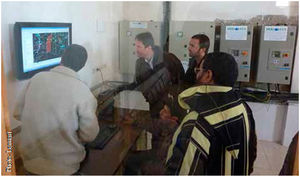Difference between revisions of "SPIS Toolbox - Credit Policy: Select/develop Suitable Financial Instruments"
***** (***** | *****) m |
***** (***** | *****) m |
||
| Line 1: | Line 1: | ||
| − | {{SPIS Banner}} | + | {{SPIS Banner}}{{Back to Finance}} |
=== '''<span style="color:#879637;">Credit Policy: Select/develop Suitable Financial Instruments</span>''' === | === '''<span style="color:#879637;">Credit Policy: Select/develop Suitable Financial Instruments</span>''' === | ||
Revision as of 12:40, 9 June 2017

Introduction
The Toolbox on Solar Powered Irrigation Systems (SPIS) is designed to enable advisors, service providers and practitioners in the field of solar irrigation to provide broad hands-on guidance to end-users, policy-makers and financiers. Risks related to system efficiency, financial viability and the unsustainable use of water resources can thus be minimized. The Toolbox comprises informative modules supplemented with user-friendly software tools (calculations sheets, checklists, guidelines). read more
Modules and tools touch upon:
- assessing the water requirements,
- comparing the financial viability,
- determining farm profitability and payback of investment in SPIS,
- sustainably design and maintain a SPIS,
- highlight critical workmanship quality aspects,
- and many more.

style="width: 160px; background-color: rgb(111, 142, 43);" | ►Back to the Module Page
Credit Policy: Select/develop Suitable Financial Instruments
When selecting or developing a loan product for SPIS it is important to ask the following questions:
- who? Market oriented producers, no subsistence production, producer groups possible;
- what? Finance for energy source and pumping system used for irrigation; energy and/or water saving technology;
- how much? Establish range of loan sum; % own-contribution of producer; % subsidy;
- when? Range of loan period (years); repayment frequency (months); disbursement in tranches;
- interest rate? From..x..% p.a. to ..x..% p.a. (range);
- collateral? Equipment, mortgages, additional collateral (guarantee scheme), non-traditional collateral (future harvest, warehouse), leasing scheme with equipment providers.
Loan products for financing SPIS usually:
- have higher initial investment sums with consequently longer repayment periods and/or high installment rates;
- need alternative guarantee schemes/ unconventional collateral;
- have higher interest rate payments due to higher credit risk and long investment period;
- focus on innovative clients, usually investing in high(er) value crops;
- should be strictly oriented towards water capacity available and the farm’s specific requirements;
- use no blueprint; every farm/enterprise is unique!
In order to prevent prohibitive loan transaction costs, consider:
- guarantee funds with public support or insurance;
- leasing schemes with pumping system providers and others;
- group financing approaches for producer groups;
- public subsidies and sponsoring;
- favorable refinancing options for the financial institution (e.g. subsidized interest rates offered by donors/public entities).
In order to overcome the information gap in respect of the new technology, introduce additional activities such as:
- encouraging (potential) clients to get informed and consult technical advice;
- training and sensitization of loan staff on basics about the technology;
- monitoring loan performance closely;
- continuous dialogue with solar power sector.
Note: SPIS clients could become future clients for other financial products (cross selling).
Outcome/Product
- Guidelines and Procedures: including assessment and decision guidelines, target key performance indicators (KPIs).
Data Requirements
- Comparable clients liquidity pattern in current agricultural portfolio.
Compute, prepare
- repayment plan (with varying interest rates, repayment periods and repayment frequencies);
- profitability margins by crops and farm sizes;
- tables for evaluating types of collateral;
- list of eligible crops;
- list of eligible irrigation systems and average investment cost per component;
- list of eligible SPIS configurations and average investment cost per component (see DESIGN and GET INFORMED;
- list of eligible types of collateral.
People/Stakeholders
- Management level of financial service providers;
- Experienced credit staff (senior, agrifinance);
- Associations of producers / potential borrowers;
- Agricultural extension services;
- Research and training institutes (e.g. environmental agency);
- Providers of service, technology and inputs.
Important Issues
- Prevent prohibitive transaction costs for borrowers;
- Overcome information gap of financial operator;
- Note that standardization potential is limited.
- Select excellent loan staff for this segment with corresponding background and experience (train them!).




















